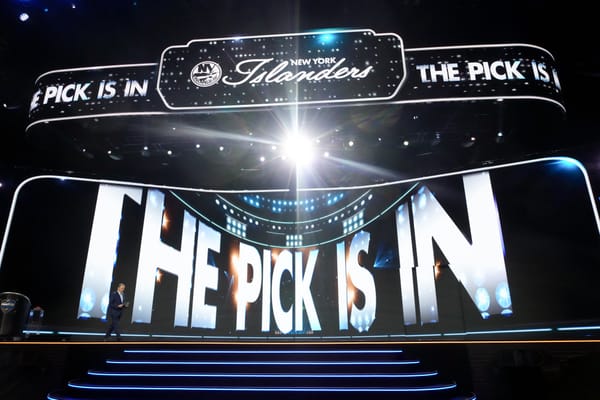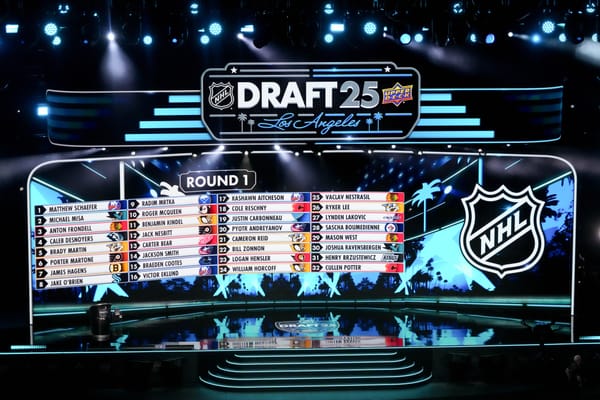Has Kevin Hayes Been #ActuallyGood for Rangers In 2017-18?
Kevin Hayes hasn’t scored as much this year as he did last year. That hardly tells the story about his play.
One of the most interesting things about the 2017-18 New York Rangers is center Kevin Hayes, and more specifically how he is perceived as a player. A quick glance at NHL dot com would show that the Rangers pivot sits 12th in team scoring, with players such as David Desharnais and Jesper Fast ahead of him. Looking at this, I find, evokes a reaction as to say, Hayes is being outscored by someone signed to be a fourth line center and a perennial bottom six forward?
I think this is a reaction many fans have had, especially when you consider Hayes is in an the ever infamous “contract year” and one of the many restricted free agents of prominence that need to be dealt with. This may present a dilemma, but I think the situation is clear. To borrow from ESPN’s 30 for 30 voice over announcer, “what if I told you that Kevin Hayes was playing better in 2017-18 than he was at this point in 2016-17?”
Hayes has been a talking point in the Blueshirt Banter Twitter group chat, so I decided to write an article on him. You can consider this the third part of a series on Ranger RFAs, as Shayna wrote about Brady Skjei here, and Mike just recently put together a piece on J.T. Miller. With that out of the way, let us look at some numbers.
As I said in the intro, through 30 games Kevin Hayes sits 12th on the New York Rangers in scoring with 12 points. Of those 12 points, nine are primary points and it just so happens these points have all been picked up 5v5. Through 30 games last season, Hayes had 21 points, 17 of which were primary points. Twelve of those points came 5v5, 10 of which were primary points.
So, in roughly the same span of 5v5 TOI, 13.12 a game this year and 13.28 a game last year, Hayes has the same amount of points and one fewer primary point; from that perspective things are good. The biggest difference is lack of production on special teams and it makes sense based on his usage.
This season Hayes has spent 23:40 on the power play and 62:42 killing penalties. Last year those splits were 42:03 and 38:22 respectively. The departure of Derek Stepan has led to Hayes killing more penalties, and the addition of Mika Zibanejad has led to less power play time.
With that in mind, do you feel better that Hayes only has 12 points? Do you feel better that all his points have been 5v5 and mostly primary?
If Hayes had picked up five extra secondary assists he’d sit with 17 points, which would be four points shy of his total at this point last year. On paper it would be a prettier picture, but it would be a bit of a facade.
What is a prettier picture is some of Hayes’ underlying numbers, and those are the ones worth focusing on.
At this point last year, Hayes was a bit of a black hole in terms of possession. Among forwards with at least 10 games played, he was 13th with a CF% Rel of -5.23. He also ranked 13th in SF% Rel with a mark of -5.93. As for SCF% Rel he was 12th (-3.93). The one area of success was GF% Rel with a mark of 8.92 which was fourth best on the team among forwards.
What this suggests is that Hayes was a player who was running and gunning, and getting lucky when goals were scored. It would explain bleeding shots and possession, and I can only imagine his numbers if his ability to drive scoring chances was more efficient.
That brings us to this year where Hayes has been much better in the metrics cited above. He is currently sixth in CF% Rel at 0.52, seventh in SF% Rel (2.69). As for SCF% Rel he is third with 3.00 and in GF% he is fifth with a mark of 3.33.
With all of that behind you, here’s the side by side look.
Kevin Hayes 2017-18 vs 2016-17
| Metric | 2017-18 | 2016-17 | Δ |
|---|---|---|---|
| CF% Rel | 0.52 | -5.23 | 5.75 |
| SF% Rel | 2.69 | -5.93 | 8.62 |
| SCF% Rel | 3.00 | -3.93 | 6.93 |
| GF% Rel | 3.33 | 8.92 | -5.59 |
| Off. Zone Faceoff % | 42.37 | 37.83 | 4.54 |
Quite the turnaround for Hayes wouldn’t you say?
I think when you look at things as a whole, you realize that Hayes is playing pretty well this season. The biggest difference in terms of points is not getting extra points on the power play, and that’s something explained partially by time on ice in that area.
He is also making good plays defensively to generate chances which just haven’t gone in.
Hayes is really good at hockey pic.twitter.com/ikPlcs51Kb
— Shayna (@hayyyshayyy) November 16, 2017
He is moving the needle in the underlying areas which suggest that the points will come. There have been a number of occasions this season where Hayes has been on a 2-on-1, often times with Rick Nash, and the puck just hasn’t gone in.
annnnnd another pic.twitter.com/Y3oRJMYz1m
— Shayna (@hayyyshayyy) November 11, 2017
Nash & Hayes come close while short-handed pic.twitter.com/KHhjfPdj1n
— Shayna (@hayyyshayyy) November 20, 2017
Had those pucks gone in you are talking about a few extra primary points for Hayes and it is a situation where fans aren’t agonizing that he’s behind Desharnais in terms of offensive production.
The interesting thing is going to be what happens in terms of salary on a new contract. Hayes was signed to two-year entry level contract at $900,000 and then signed a two-year extension worth $2.6 million a season.
At this point in his career, he’s got 142 points in 264 games for a points per game average of 0.54. Of those 142, 114 are primary points which converted to a percent is 80%. This is an alarming stat which speaks to the fact that Hayes is more of a driver than a passenger.
Hayes turns 26 in May, which means any deal the Rangers give him will have to be more than a year to avoid a situation where he walks to unrestricted free agency in July of 2019. I say this because most fans would prefer Hayes getting another “show-me” deal before committing money to him long term.
The other variable is that the cap is set to rise from the current rate of $75 million to anywhere from $78 million to $82 million. This means the Rangers could end up paying Hayes a little more in AAV, but it will still represent a fair amount of the salary cap. For example, the Rangers signed Mika Zibanejad to a deal with a cap hit of $5.35 million which represented 7.13 of the cap.
Here are a few options the Rangers could go, and here’s what it would look like in terms of cap percentage.
Potential Cap Hits for Kevin Hayes
| Cap Hit | Salary Cap | % of Cap |
|---|---|---|
| $4,750,000 | $78,000,000 | 6.09% |
| $5,000,000 | $78,000,000 | 6.41% |
| $5,250,000 | $78,000,000 | 6.73% |
| $6,000,000 | $78,000,000 | 7.69% |
| $4,750,000 | $80,000,000 | 5.94% |
| $5,000,000 | $80,000,000 | 6.25% |
| $5,250,000 | $80,000,000 | 6.56% |
| $6,000,000 | $80,000,000 | 7.50% |
| $4,750,000 | $82,000,000 | 5.79% |
| $5,000,000 | $82,000,000 | 6.10% |
| $5,250,000 | $82,000,000 | 6.40% |
| $6,000,000 | $82,000,000 | 7.32% |
I feel the numbers above represent a good blend for Hayes in terms of options. I use the cap hit of $6 million as an “upper” limit to create context for what total that would represent against the cap compared to Zibanejad who is the Rangers’ first line center.
As for what he should get paid, I think two comparable used in my Mika Zibanejad story from the summer make sense here.
Vincent Trocheck, Florida Panthers ($4.75M AAV)
The Panthers signed a 22-year-old Trocheck to a six-year pact worth $28.5 million with an AAV of $4.75 million on July 2, 2016. Prior to signing his deal, Trocheck scored 37 goals and added 46 assists for 83 points in just 146 games. That breaks down to 0.25 goals, 0.32 assists and 0.57 points per game. This was a case where the Panthers paid a little much early, but the returns thus far have been good. They also signed him to age 28, so they didn’t have to buy too many UFA years.
This move has paid off big for Florida, as Trocheck’s is currently averaging over a point per game with 31 points in 30 games.
Brayden Schenn, St. Louis Blues ($5.125M AAV)
Brayden Schenn, then of the Philadelphia Flyers, was 24 on July 25, 2016 when he signed a deal worth $20.4 million over four years with an AAV of $5.125 million. Before the deal, Schenn tallied 84 goals and 107 assists for 191 points over 354 games played. That breaks down to 0.24 goals, 0.30 assists and 0.54 points per game. He was dealt to the St. Louis Blues on draft night for Jori Lehtera, the No. 27 overall of the 2017 draft (Morgan Frost) and a future first rounder just one year after signing him to a contract extension. It is not clear why he traded, but it doesn’t really matter in the context of this piece.
This was a solid deal for Philadelphia as Schenn averaged 0.70 points per game (55 points in 79 games) in his first season after signing the deal, and he’s been amazing for the Blues averaging 1.19 points per game (37 points in 31 games).
Based on Hayes’ production and improvement in underlying numbers, it isn’t hard to imagine him having a big year as a 26-year-old and 27-year-old and beyond.
We have seen Hayes dominate on goals before, and it is moments like this which highlight the player he can be.
He’s also received praise for those covering the game nationally, and one of Hayes’ biggest fans is Dimitri Filipovic of Sportsnet. Some of the tweets are older, but you will notice a theme.
I can't speak to how much he 'wants it', but every time I watch Kevin Hayes seems to make the best possible play with the puck in the OZ.
— Dimitri Filipovic (@DimFilipovic) February 13, 2016
Guys this big are not supposed to be this skilled. He does things most other players can't even dream of doing. pic.twitter.com/8h6nO4J8kx
— Dimitri Filipovic (@DimFilipovic) October 31, 2016
That's obviously not even accounting for his sporadic usage. When you adjust for ice-time he looks even better. pic.twitter.com/05BKleEXm7
— Dimitri Filipovic (@DimFilipovic) November 2, 2016
58 of Kevin Hayes' 62 points since the start of last year are primary points. That's a ridiculous start to his career. He's very, very good.
— Dimitri Filipovic (@DimFilipovic) November 8, 2015
How the Rangers handle Hayes is going to be very interesting, because he is a special player who is having a good season and could play a much larger role in the future. Cap space shouldn’t be an issue, and hopefully Jeff Gorton can sign him to a deal that gives him the flexibility to make additional moves to bolster the roster.
Stats via Natural Stat Trick. Support their Patreon if you can.





